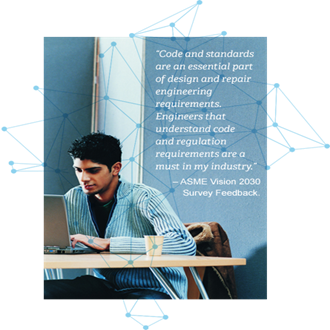Engineering Student Resources
OVERVIEW
Did you know that almost 50 percent of early career engineers lack standards knowledge? ASME project, Vision 2030, assessed ME education in the U.S. by surveying 2500 industry engineering supervisors, early career mechanical engineers and ME Department Heads and found that 46.9% of industry supervisors state a weakness of standards understanding among BSME graduates and 48.3% of early career engineers state their own weakness of standards understanding. Find out different ways to get involved in standards activities and learn more about standards and certification processes.
Standards are everywhere. In fact, essentially all modern mechanical devices rely on one or more engineering standards in their manufacturing processes. Standards provide efficiency, produce standardized products, improve trade and commerce, and perhaps, most important, meet safety and quality objectives. Manufacturing to a certain standard implies a certain level of quality to the customer.
Standard – A set of technical definitions, instructions, rules, guidelines, or characteristics set forth to provide consistent and comparable results, including:
- Items manufactured uniformly, providing for interchangeability
- Tests and analyses conducted reliably, minimizing the uncertainty of the results
- Facilities designed and constructed for safe operation
WHY STANDARDS?
Learn more about ASME and the important role that standards play in your everyday life, as well as information about their development process, through the brochure Why’s and How’s of ASME Standards & Certification.
During a time when there were few, if any, operating guidelines and inspections for steam pressure systems, many boilers were unsafe. Partly due to the explosion of the steamship Sultana and the increase in boiler explosions and accidents, the American Society of Mechanical Engineers was founded in 1880. Read more about ASME’s founders, the Society’s early history, and its impact on American industry in The True Harnessing of Steam.
Beginning with the first ASME standard published in 1884, ASME has worked to maintain its founders’ vision of developing standards that would ensure safety, reliability, and operational efficiency. Find out more on the history of ASME standards to see how ASME is constantly seeking to expand standards as technology evolves.
“Code and standards are an essential part of design and repair engineering requirements. Engineers that understand code and regulation requirements are a must in my industry and will increasingly become more widespread in other industries, as regulatory issues change and become more stringent. All industries are becoming more aware of the benefits of adherence to Code and industry standards in ensuring reliability of systems, components and structures.” – ASME Vision 2030 Survey Feedback.
HOW ARE ASME STANDARDS DEVELOPED?
Each ASME standard is developed (and maintained) by one or more volunteer committees comprised of subject matter experts. These committees are tasked with incorporating advancements in technology and lessons-learned from real world use in order to ensure the standard continues to be relevant to the industries that use it. Members of ASME Standards & Certification committees are technically qualified individuals with a concern and willingness to participate in the scope of work of a given standard.
IMPACT OF STANDARDS
Past, present, and future growth of technology introduces new standards and prompts the revision of existing standards. Aside from technology, there are also many different aspects of industry that influence standards. Standards promote the aim of prosperity with safety. See how standards evolve with the changes in technology and industry and how standards get developed for emerging industries, by taking a look at the following ASME articles.
Concentrating Solar Power: Cracking the Code
Heavy Lifting: The History of the Elevator Code
Behind The Scenes of Medical Device Development
Inservice Inspection of Nuclear Power Plant Components
Explore different facets of ASME standards, through the ASME S&C Student Brochure that presents the significance of engineering and the widespread effect standards have on our everyday lives. The articles within the ASME S&C Student Brochure were written by thirteen experts who either work for ASME or serve as volunteers on ASME standards development committees.
A Spanish translation of the ASME S&C Student Brochure is also available. Se ha desarrollado una traducción al español del Folleto de ASME Estándares y Certificación para Estudiantes. El folleto presenta la importancia de la ingeniería y el efecto generalizado de las normas en nuestra vida cotidiana.
In order to give the general public an overview and better understanding of real life situations concerning the applicability of ASME standards, ASME staff and volunteers have prepared the following example problem(s). In each example, the reader is presented with a hypothetical case/scenario and how an existing ASME standard could be used to find a way to solve the problem.
ASME Standards & Certification – Example Problem(s)
LEARN THE STANDARDS PROCESS
ASME offers Standards overview courses, which are topical, quick and easy-to-take eLearning programs covering a wide range of subjects and interest areas, including standards and certification.
ADDITIONAL CONTENT
Refer to the Standards & Certification FAQs for more information on the standards development process.
S&C Updates
Subscribe to a quarterly newsletter to keep informed about ASME Standards & Certification activities.
ASME Standards & Certification (S&C) Scholarship
The S&C Memorial Scholarship fund was established in 2017 through the generous endowment of ASME Standards & Certification. The objective of the ASME S&C Scholarship is to stimulate engineering student interests in standards and certification and the technologies addressed by those ASME activities, as well as to annually honor individuals involved in ASME S&C who have devoted their careers to the development and promulgation of ASME S&C programs.
Learning & Development Courses
Help boost your technical competence and heighten your managerial expertise! ASME courses with practical, real-life applications developed specifically for mechanical engineers and technical professionals. We offer both live and on demand formats.
ANSI Standards Learning
This web resource provides easy-to-use, self-paced educational tools for everyone who wants or needs an introduction to standards and conformity assessment activities.
